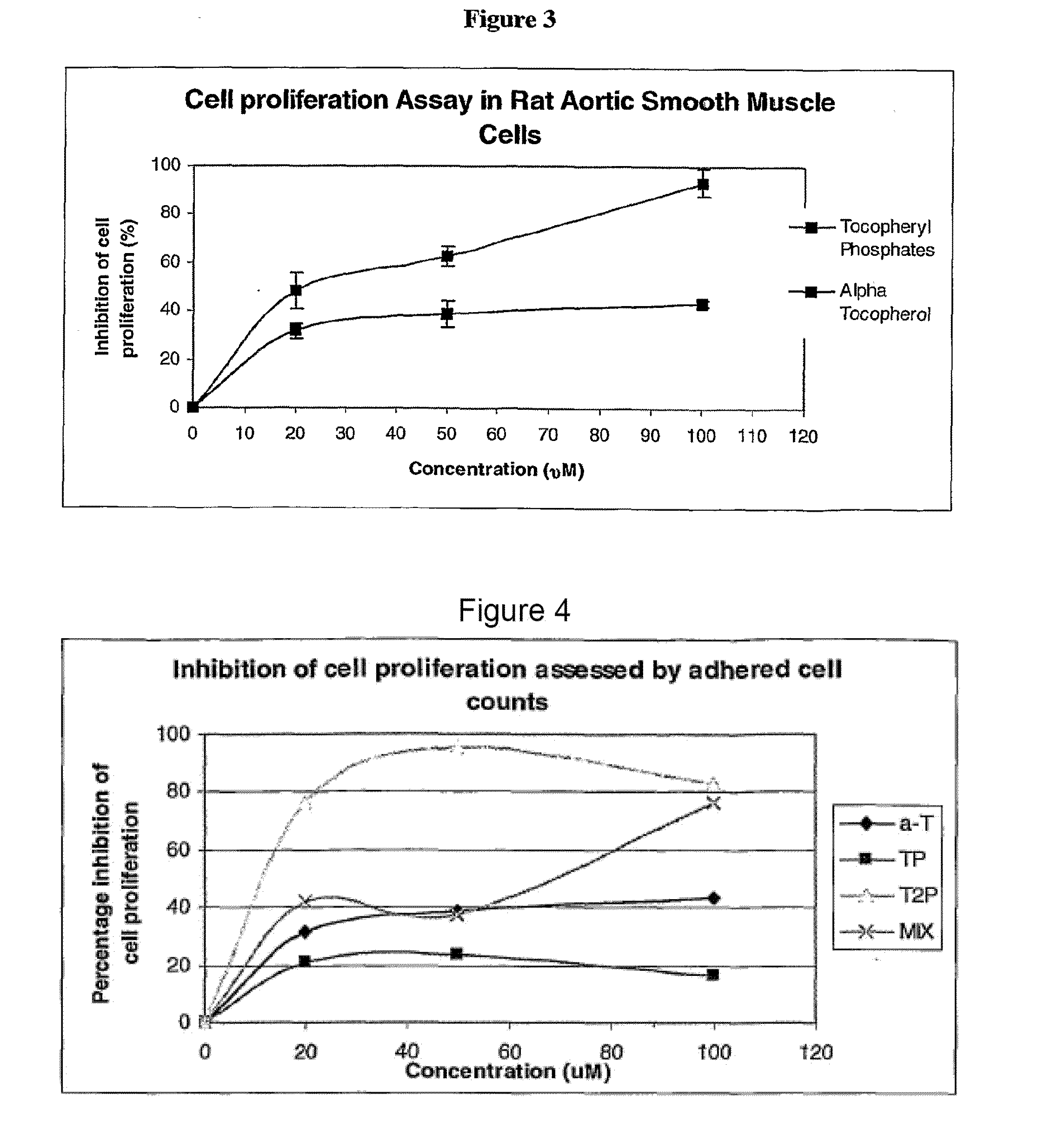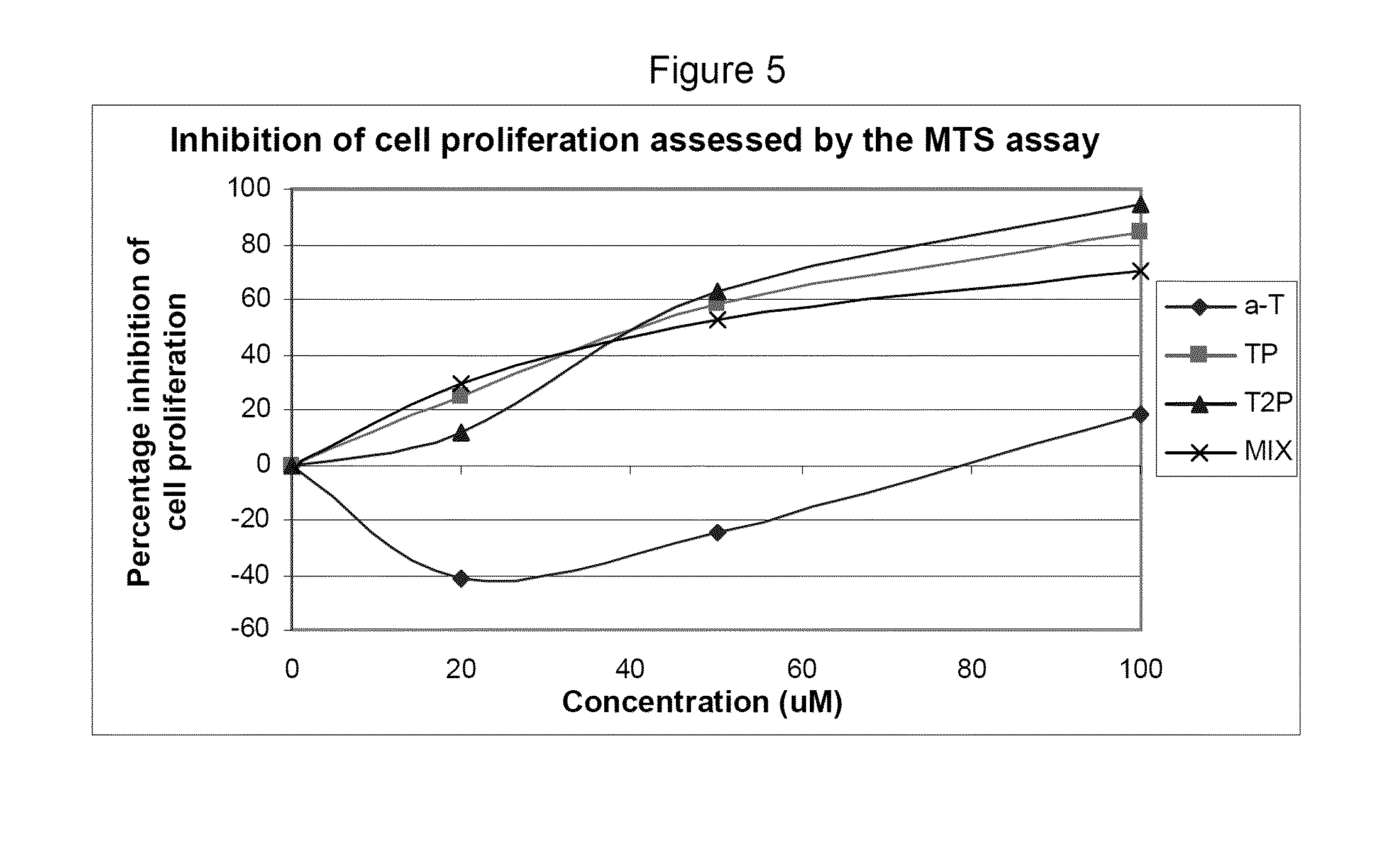Compounds having Anti-proliferative properties
a technology of compound and anti-proliferation, which is applied in the direction of drug composition, biocide, metabolic disorder, etc., can solve the problems of no current direct treatment of atherosclerosis symptoms, no effective drugs available to directly treat and reduce the formation of atherosclerosis plaques
- Summary
- Abstract
- Description
- Claims
- Application Information
AI Technical Summary
Benefits of technology
Problems solved by technology
Method used
Image
Examples
example 1
This example investigated the effect of tocopherol and tocopheryl phosphates on Rat Aortic Smooth Muscle Cell proliferation.
The Rat Aortic Smooth Muscle Cells (RASMC) used in proliferative studies are derived from the tunica intima and tunica media of healthy, fibrous plaque-free adult rat aorta. This cell line is an accepted model for the study of atherosclerosis, since increased arterial smooth muscle mass are found in the intima lesion of atherosclerosis. RASMC are cryopreserved at second passage and can be propagated at least 16 population doublings. RASMC respond to various factors by cell proliferation and hypertrophy, which are prominent indicators of atherosclerosis in vascular disease. RASMC are well suited for the study of large vessel smooth muscle cell growth and differentiation and serve as an in vitro model in correlation with live rat models.
Materials
6 well plates (Cell Counts)96 well plates (MTT Assay)DMEM / F12 Medium—GIBCO / Life TechnologiesFetal Bovine Serum (serum)—...
example 2
This example assesses the anti-proliferative activity of α-tocopheryl phosphate (TP), di-tocopheryl phosphate (T2P), the TP / T2P mixture and α-tocopherol using two types of cell counting assays: adhered cell counts and MTS assay.
The MTS proliferation assay was conducted to further support and compliment the adhered cell counts assay. The MTS assay is a well established method for the assessment of cellular proliferation which takes into account the viable cells that are adhered to the plate (as in adhered cell counts) and those that may become detached and float in the media during the course of the experiment (which would be missed in adhered cell counts).
Materials
6 well plates (Cell Counts)96 well plates (MTS Assay)DMEM / F12 Medium—GIBCO / Life TechnologiesFetal Bovine Serum (serum)Rat Aortic Smooth Muscle Cells (RASMC) p: 4 Cell Applications, Inc.Gentamicin—GIBCO / Life TechnologiesCell Titer 96 Aqueous One Solution (MTT) PromegaEthanol (EtOH), 1 / 1000Tocopherol SIGMA (0, 20, 50, 100 μM...
example 3
The aim of this study was to compare the effects of a TP / T2P mixture with tocopherol on the expression of CD36, the uptake of oxidised-LDL (oxLDL) and the growth of human THP-1 monocytes in vitro.
Methods
Cell Culture: Tocopherol and the TP / T2P mixture were each dissolved in ethanol, and the concentrations of the stock solutions were confirmed spectrophotometrically. Monocytes (THP-1) were grown in RPMI / 10% FCS.
Labeling oxLDL. OxLDLs (90% to 100% oxidation) were purchased from Intracell Corp. Small amounts of LDL were oxidized with CuSO4 (20 mmol / L) at 37° C. for 18 to 22 hours. LDL oxidation was confirmed by the formation of a characteristic smear band on an agarose gel. Labeling of oxLDL was done basically as previously described. OxLDLs were incubated at 37° C. with DiO (Molecular Probes) in lipoprotein-deficient serum (Sigma) for 15 hours. The labeled oxLDLs (oxLDL-DiO) were purified by ultracentrifugation over a KBr gradient and dialyzed against several changes of saline-EDTA (1....
PUM
| Property | Measurement | Unit |
|---|---|---|
| elasticity | aaaaa | aaaaa |
| density | aaaaa | aaaaa |
| concentration | aaaaa | aaaaa |
Abstract
Description
Claims
Application Information
 Login to View More
Login to View More - R&D
- Intellectual Property
- Life Sciences
- Materials
- Tech Scout
- Unparalleled Data Quality
- Higher Quality Content
- 60% Fewer Hallucinations
Browse by: Latest US Patents, China's latest patents, Technical Efficacy Thesaurus, Application Domain, Technology Topic, Popular Technical Reports.
© 2025 PatSnap. All rights reserved.Legal|Privacy policy|Modern Slavery Act Transparency Statement|Sitemap|About US| Contact US: help@patsnap.com



